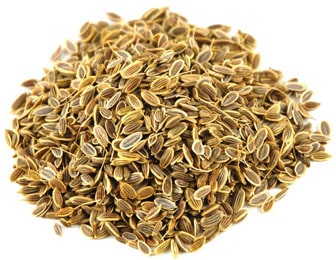Shatapushpa, Dill Seeds (Anethum Graveolens) – Properties, Benefits & Dosage

Description of Plant
Anethum graveolens, also known with the names like Dill or Shatapushpa. This herb grows annually. It not only grown for vegetable use or for aromatic leaves and seeds, but also for its attractive and beautiful foliage and flowers used for ornamental display.
This plant grows up to 40 to 60 cm. The stems are clad with lacy, delicate, aromatic leaves of blue green color. These leaves are floosy type, divided into fine pinnate structures. These have best flavor during the opening of first flower. The flowers of the Shatapushpa are hermaphrodite. These are pollinated by bees. The yellow, scented flowers of the plant blooms and develop into large, flat compounds known as umbels. The seeds are also enriched with aromatic character. Seeds are not of true kind seeds. These are flat, small and very light. The seeds are of very small size, known as dry fruits, schizocarps. Fruits of the plants are of oval shaped, compressed with three longitudinal ridges on its back and three lines in between them, other two on the flat surface. The fruit taste matches with the taste of caraway. This plant has one main tap root system that provides support to entire plant. The main stem or stalk carries heavy flower clusters. Due to these clusters and the long size of the stalk, this plants needs help sometimes.
General Description
Anethum graveolens or Shatapushpa used for treatment of ailments since ancient times. It is a very popular herb, known for its spice and essential oil. This plant belongs to Apiaceae family.
It is a plant with beautiful, sweat fragrance. The genus is derived from the Greek word aneeson or aneeton, means strong smell. The common name dill arises from Norse word dilla which means soothe.
The Sanskrit name of the plant is Shatapushpa, other names are also like dill and soya. This plant is used by Egyptian doctors 5000 years ago. In the middle ages, it was in use to protect against witchcraft. Greeks used this plant for getting sleep.
This plant shows its effect on kapha and vata. It helps to give relief in ulcers, abdominal pain, uterine pain and eye diseases. It cures ‘vata’ and ‘kapha’ dosha. This plant is known to have anti-convulsion, anti-cramp, anti-emetic, antimicrobial, anti-inflammatory, analgesic, gastric and mucosal protective properties. It is used for increased progesterone concentration, and many other effects.
This plant contains various important chemical constituents. Anethum graveolens contained essential oils, proteins (15.68%), carbohydrates (36%), fatty oil, moisture (8.39%), fiber (14.80%), ash (9.8%) and mineral elements such as calcium, potassium, magnesium, phosphorous, sodium, vitamin A and niacin. Fruits of Anethum graveolens contains essential oil containing major compounds: carvone (30 – 60%), limonene (33%), a-phellandrene(20.61%), including pinene, diterpene, dihydrocarvone, cineole, myrcene, paramyrcene, dillapiole, isomyristicin, myristicin, myristin, apiol and dillapiol. The extract of dill plant have total phenol and total flavonoids.
Essential oil mainly composed of components present in leaves and flowers. Leaves active compounds are limonene, a-phellandrene and phellandrene. Flowers compounds are limonene, a-phellandrene and anethofuran.
Classification
- Kingdom – Plantae
- Subkingdom – Tracheobionta
- Superdivision – Spermatophyta
- Division – Magnoliophyta
- Class – Magnoliopsida
- Subclass – Rosidae
- Order – Apiales
- Family – Apiaceae
- Genus – Anethum
- Species – A. graveolens
Habitat
This plant suits and grows in light and medium soil enriched with minerals. It cannot grow in the shades.
The plant matures during the summers, so more water retention is required. It can also tolerate cold and can grow there.
It is the native of Asia and Mediterranean but also found in the parts of Europe, America, Germany, Greece, Norway, Sweden, Spain, Central China and more.
Names of the shatapushpa
- Botanical names: Anethum graveolens
- Hindi name: Soyo
- English name: Dill, Dil, Dill plant, Indian Dill
- Telugu name: Sadapa Vittulu
- Tamil name: Satakuppi
- Bengali name: Saluka
- Marathi name: Shepu
- Gujarati name: Suva
- Kannada name: Its seeds are called Shataapu and the plant is called Sabbasige soppu
- Arabian name: Shibith
- Farsi: Shebet, Sheveed
- French: Aneth odorant, Fenouil bâtard
- Georgian: K’ama, Kama, Ok’rop’i, Okropi
- German: Dill, Gurkenkraut
- Russian: Укроп, Ukropo
Ayurvedic Properties
| Hindi / Sanskrit | English | ||
| Rasa | Katu, Tikta | Taste | Pungent, Bitter |
| Guna | Laghu, Teekshna | Physical Property | Light, Sharp |
| Virya | Ushna | Potency | Hot |
| Vipaka | Katu | Metabolic Property (After Digestion) | Pungent |
Effects on Doshas
It balances vata and kapha doshas and increases pitta.
Classical Categorization
| Charak Samhita | Kashyapa Samhitaa |
|
|
Ancient Verse About Shatapushpa

Bhavprakash nighantu edition of 1998: verse 89-92, page no-35-36.
It states that the different names of soya are shatapushpa, shatahva, madhura karvi, missi, atilambi, sitchatra and sahintchatra.
Soya is light, aggravates pitta and promotes digestive fire and having pungent taste with hot potency. This manages fever, vata, kapha, pain and eye diseases.
References:-
The Bhavprakash nighantu with elaborated Hindi commentary by Padmashri prof. K.C. Chunekar, edited by Dr. G.S. Pandey: Edition of 1998, verse 89- 92, page no-35-36.
Practical Uses of Shatapushpa
As from whole description of the plant, we get to know that shatapushpa is known for its antiseptic, carminative, digestive, diuretic, antibacterial, laxative, breast milk stimulating and blood pressure lowering properties.
The seeds and the leaves of the plant are used to combat various problems.
Aid in Digestion
The plant contain essential oils that helps to activate the bile secretions and digestive juices and peristaltic motions of intestine. This makes relief in constipation and indigestion.
Useful in Insomnia
The essential oils are rich in avonoids and vitamin-B complex, helps to stimulate secretions of hormones, which help people to sleep well.
Good for bone Health
Plant has plenty amount of calcium, helps to recover bone density, loss due to problems like osteoporosis and rheumatoid arthritis.
Controls diabetes
It controls diabetes and insulin levels as it manages serum lipids and insulin levels in corticosteroid-induced diabetes.
Prevent excess Gas
This contains carminative properties so helps to reduce gas.
Boosts Immune System
This plant has elements so can fight with various microorganisms and boosts immunity.
Calms down Hiccups
Plant has properties through which it can control hiccups that arise due to reasons like hyperactivity, allergies, hypersensitivity or trapped gas.
Prevents and cures diarrhea
The main cause of this problem is indigestion and due to microbes. This plant contains
monoterpenes and avonoids, which are known to act on microbes.
Prevents dysentery
The chemical constituents in this plant are also helpful in treating dysentery as plant shows effect on fungus, which is the main reason of dysentery.
Anti-inflammatory
This plant helps to reduce inflammation caused due to disorders like gout, arthritis and rheumatoid arthritis.
Parts used
- Fruits
- Essential oils
Dosage
- Fruit powder – 2 to 4 gm with plain water after meals.
- Essential oils – 2 to 3 drops.
Side effects of using high Shatapushpa
Over-dosage can cause burning.
This is best to avoid this during menstrual periods.
Ayurvedic Product From Shatapushpa
Pippalyadi Thailam
Pippalyadi Thailam is a great herbal formulation by Planet Ayurveda. This is prepared by using mixture of different herbs. This formulation maintains vata and kapha.
SALE PRICE
For Price Quote, Kindly Mail Us at – herbalremedies123@yahoo.com



